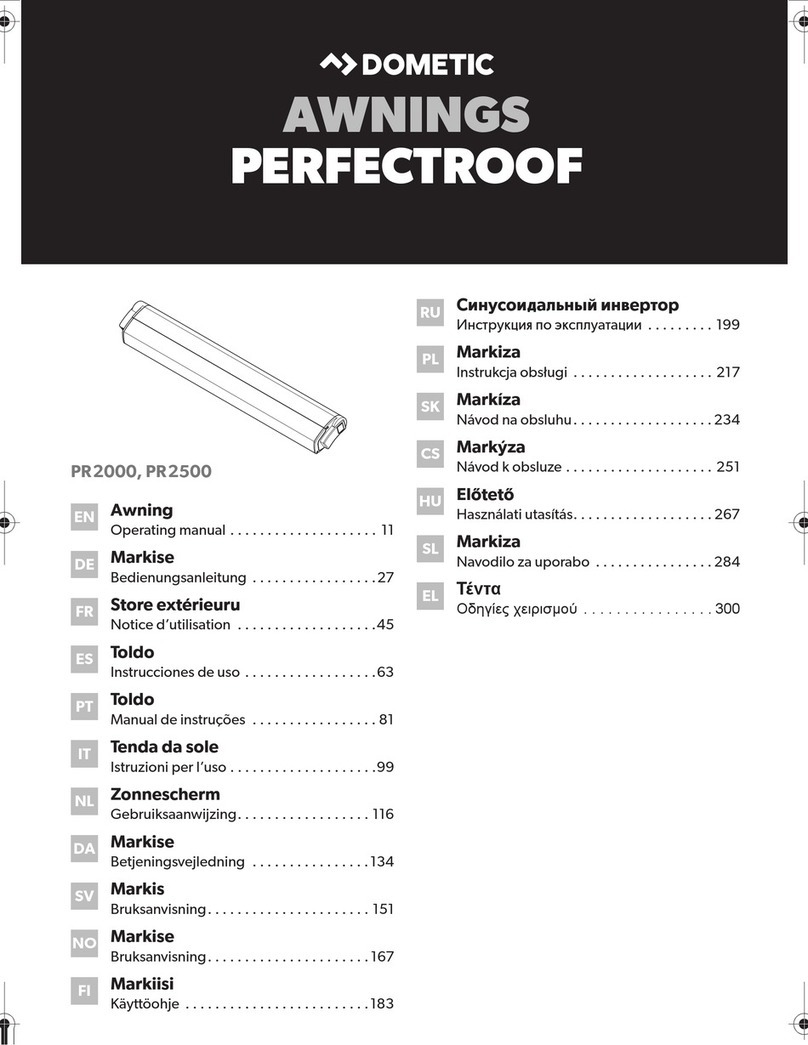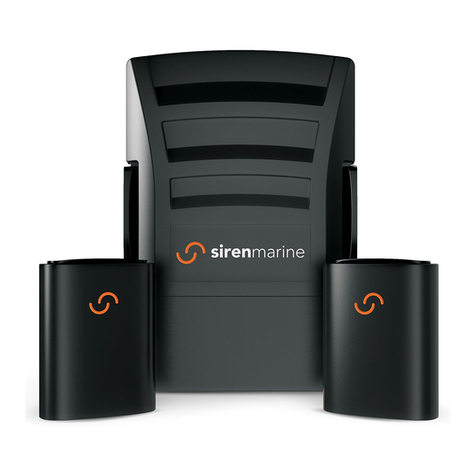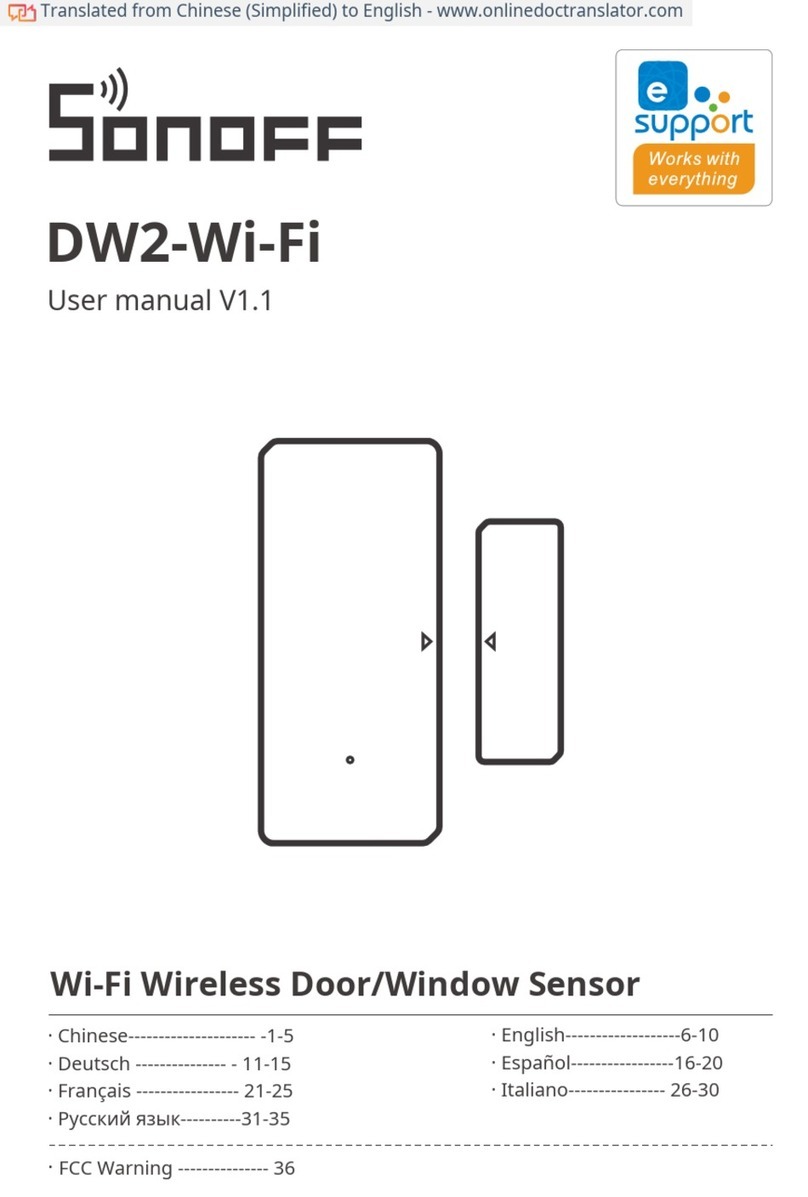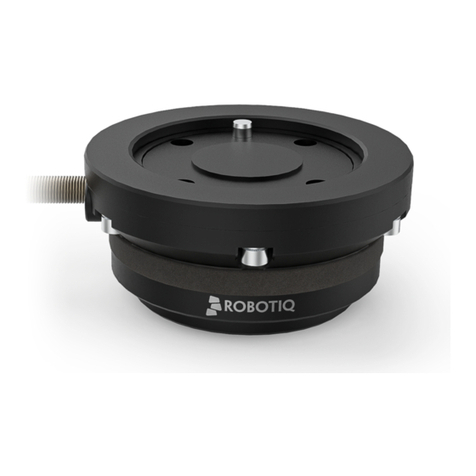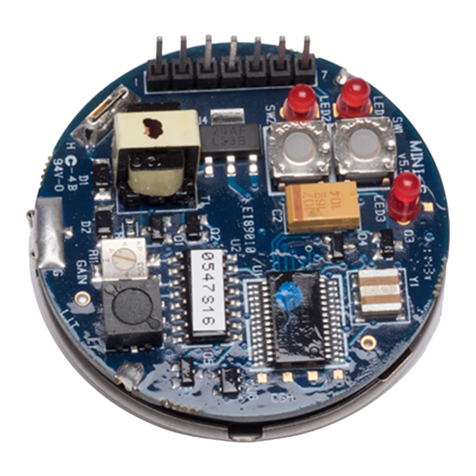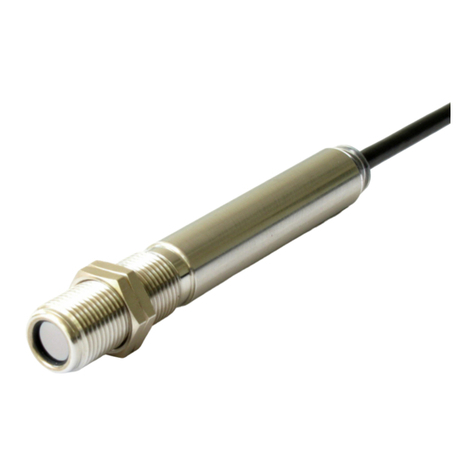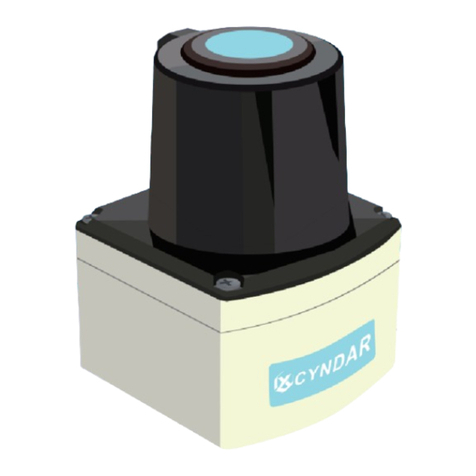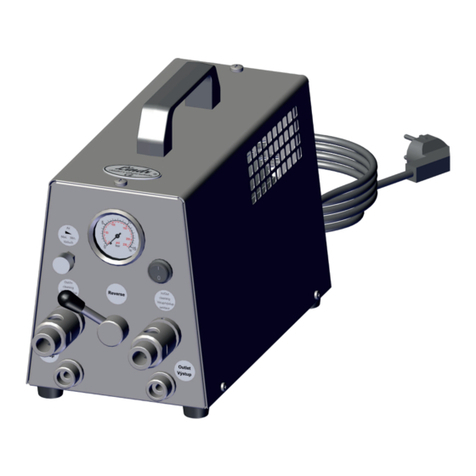Southwest Microwave 300B User manual

Southwest Microwave, Inc.
Security Systems Division
TECHNICAL MANUAL
FOR
MIL PAC MODELS
300B, 310B, 380 and 385
MIL PAC 380 or 385
MIL PAC 300B or 310B
SOUTHWEST MICROWAVE, INC
Security Systems Division
9055 South McKemy Street
Tempe, Arizona 85282
Tel: (480) 783-0201
Fax: (480) 783-0401
E-mail: [email protected]
Web: www.southwestmicrowave.com

2
TABLE OF CONTENTS
Introduction............................................................................................................................................................3
Equipment Supplied............................................................................................................................................... 3
Optional Equipment...............................................................................................................................................9
Applications.........................................................................................................................................................10
Unpacking and Tripod Setup ...............................................................................................................................12
MIL PAC 300B Operating Instructions............................................................................................................... 12
MIL PAC 300B Setup and Testing...................................................................................................................... 13
MIL PAC 310B Operating Instructions............................................................................................................... 15
MIL PAC 310B Setup and Testing...................................................................................................................... 16
MIL PAC 380 and MIL PAC 385 Operating Instructions................................................................................... 17
MIL PAC 380 and MIL PAC 385 Setup and Testing.......................................................................................... 18
Powering Down and Packing Up......................................................................................................................... 19
Limited Warranty................................................................................................................................................. 19
Returning Equipment under Warranty.................................................................................................................20
Returning Equipment for Non Warranty Repair.................................................................................................. 20
Replacement Parts................................................................................................................................................20
Copyright Southwest Microwave, Inc. November 2003 – MIL PAC.................................................Printed in USA

3
INTRODUCTION____________________________________________________________________
This manual covers the setup and operation of the Models MIL PAC 300B and MIL PAC 310B Relocatable Rapid Deployment
Microwave Intrusion Links and Models MIL PAC 380 and MIL PAC 385 Relocatable Rapid Deployment Microwave
Transceivers. Please refer to the individual Data Sheets and Technical Manuals for Models 300B, 310B, 380 and 385 for
additional information not covered in this manual.
These portable relocatable sensors are ideal for short-term protection of vital assets such as parked aircraft, construction sites,
freight yards or anywhere the perimeter may be moved or changed.
EQUIPMENT SUPPLIED______________________________________________________________
Each MIL PAC 300B consists of one Model 300BT Transmitter, one Model 300BR Receiver, one MP01 Monitor Pac with
mating connector, charging transformer and cable, one BP01 Battery Pac with mating connector, charging transformer and
cable, two MT10 Tripods, two interconnect cables, one RF radio alarm transmitter with two foot whip antenna and two fitted
carrying cases.
Each MIL PAC 310B consists of one Model 310BT Transmitter, one Model 310BR Receiver, one MP01 Monitor Pac with
mating connector, charging transformer and cable, one BP01 Battery Pac with mating connector, charging transformer and
cable, two MT10 Tripods, two interconnect cables, one RF radio alarm transmitter with two foot whip antenna and two fitted
carrying cases.
Each MIL PAC 380 consists of one Model 380 Transceiver, one MP01 Monitor Pac with mating connector, charging
transformer and cable, one MT10 Tripod, one interconnect cable, one RF radio alarm transmitter with two foot whip antenna
and fitted carrying case.
Each MIL PAC 385 consists of one Model 385 Transceiver, one MP01 Monitor Pac with mating connector, charging
transformer and cable, one MT10 Tripod, one interconnect cable, one RF radio alarm transmitter with two foot whip antenna
and fitted carrying case.
Reference Figures 1-8 for supplied equipment.
Figure 1 shows a side view of the various sensors with the tilt and swivel limits of the swivel assembly plus the MS connector
location where the interconnect cable attach from the MP01 or BP01 to the sensor.
Figure 1 – MS Connector Locations
20
o
MAX TILT
ANY DIRECTION
10.6 in.
(27cm)
Dia.
10.125 in.
(25.7cm)
380 385
300BR or 310BR300BT or 310BT

4
Figure 2 shows the MP01 Monitor Pac. The MP01 connects to the MIL PAC 300BR receiver, MIL PAC 310BR receiver, MIL
PAC 380 transceiver or MIL PAC 385 transceiver with the supplied interconnect cable. It houses a 5 AH battery to power the
sensor and associated electronics, a RF alarm transmitter, a test/alignment meter to assist with setup, audible and visual alarm
indicators, a shielded terminal strip and on/off switches. On the case side is the mount for the two-foot whip antenna. There
are two MS style connectors on the outside of the MP01. One is for connecting to the sensor and the other for connecting to an
optional external DC source such as a power supply, solar panel or larger battery. A mating connector is provided.
Figure 2 – MP01 Monitor Pac
6 inches
(152mm)
MILLIAMPERES
2A
ONONOFF OFF ONOFF
LIGHT OFF
COM
12VDC
N.O. N.C.
FUSE
MP01
MODEL
SOUTHWEST
MICROWAVE
MADE IN USA
AUDIO
0
.4 .6
.2
D.C.
DO NOT TURN ON RADIO WITHOUT
ANTENNA PROPERLY CONNECTED.
DAMAGE TO RADIO MAY RESULT.
WARNING
BATTERYPOWER RADIO
CHARGER
REG P/S
RADIO
-+
16VAC
OFF
P/S ALIGN
SENS
.8
1
12 inches
(305mm)
9 inches
(229mm)
NEG
NEG
TO TRANSCEIVER
A
EXT 12VDC
A

5
Figure 3 shows the BP01 Battery Pac. The BP01 connects to the MIL PAC 300BT transmitter or MIL PAC 310BT transmitter
with the supplied interconnect cable. It houses a 5 AH battery to power the sensor and associated electronics, a shielded
terminal strip and on/off switches. There are two MS style connectors on the outside of the BP01. One is for connecting to the
sensor and the other for connecting to an optional external DC source such as a power supply, solar panel or larger battery. A
mating connector is provided.
Figure 3 – BP01 Battery PAC
TO TRANSMITTER
NEG
NEG
A
EXT 12 VDC
A
6 inches
(152mm)
OFF ON
POWER
FUSE
1A
MADE IN USA
MICROWAVE
SOUTHWEST
POS
POS
NEG
NEG
SP2SP1TEST
-
12VDC 16VAC
+
CHARGER
MODEL
BP01
OFF ON
BATTERY
12 inches
(305mm)
9 inches
(229mm)

6
Each Model BP01 and MP01 includes a step-down transformer to charge the internal batteries through the 16.5 VAC
terminals. It can also be used to power the system. Figure 4 shows the Model PT61 220 VAC to 16.5 VAC transformer and the
Model PT62 110 VAC to 16.5 VAC transformer.
Figure 4 – PT61 and PT62 Transformers
Each MP01 Monitor Pac includes a RF alarm transmitter to transmit the relay closure of the sensor. When activated the
transmitter will send a 10 watt, 27.255 MHz, digital encoded, FSK modulated, signal to its companion receiver. The
transmitter has full supervision capabilities. Two 8-position switches set the units system code to one of 65,536 possibilities. A
two-foot whip antenna is also included. The antenna hardware is mounted to the side of the MP01 as shown in Figure 2. The
maximum range is 1 (one) mile when the MP01 is at ground level. Figure 5 shows the RF alarm transmitter and antenna. Other
optional radios are also available. Please contact the factory.
Figure 5 – RF Alarm Transmitter and Antenna
PT62PT61
DO NOT TURN ON RADIO WITHOUT
ANTENNA PROPERLY CONNECTED.
DAMAGE TO RADIO MAY RESULT.
WARNING

7
Figure 6 shows three views of the MT10 heavy-duty military style, lightweight olive drab tripod. (It is also shown in the
pictures on the front page). An extended view when set up, a collapsed view when in the carrying case and a top view. One
MT10 is included with each MIL PAC 380 and MIL PAC 385. Two MT10 tripods are included with each MIL PAC 300B and
MIL PAC 310B. The MT10 has a maximum leg extension of 36 inches (914.4mm). With the legs fully extended, the height
adjustment with the center shaft is 18 to 32 inches (457.2 to 812.8mm). The tripod weights approximately 10 pounds (4.5 kg).
Each foot of the MT10 tripod has a hole that can be staked to the ground or weighted with sandbags. The tripod has the ball
swivel assembly with handle attached to the shaft socket. This connects the sensor to the MT10 tripod.
Figure 6 – MT10 Tripod
27.9"
(708mm)
9.9"
(251mm) 8.2"
(208mm)

8
Each MIL PAC system includes a fitted carrying case as show in Figure 7. One case is included for the MIL PAC 380 and
MIL PAC 385. Two cases are included for the MIL PAC 300B and MIL PAC 310B (one case for the transmitter and one case
for the receiver). The case will hold one sensor, one MT10 tripod, one MP01 or BP01, one AC transformer, one interconnect
cable, one charger cable, and one RF alarm transmitter antenna.
Figure 7 – Fitted Carrying Case
The interconnect cable that is supplied is factory assembled. The mating connector for the optional DC input is a bare
connector that requires soldering wires to pin “A” (+12 VDC) and pin “D” (Ground). The distance between the optional
source and MP01 or BP01 determines the wire length and gauge. The connectors on the wire are determined by optional
source requirements. The wiring and soldering of this connector is the responsibility of the contractor or installer. Figure 8
shows a side view and soldering side of the connector.
Figure 8 – Mating Connector
A
D

9
OPTIONAL EQUIPMENT_____________________________________________________________
RP01 Relocatable Receiver Monitoring Unit is used to monitor alarm activity from the MIL PAC sensors. The RP01 has a 16
channel receiver (compatible with the MIL PAC systems transmitters), a LCD display for transmitter alarm with low battery
and transmitter status, audible alarm, LED alarm, a 5 AH internal battery, 16.5 VAC transformer, antenna, 12 VDC input
terminals and 16.5 VAC input terminals. The RP01 is shown in Figure 9.
Figure 9 – RP01
OFF ON
POWER
FUSE
1A
CHARGER
OFF ON
RADIO
AUDIOLIGHT
OFF
12VDC
16VAC
-
+
ALARM
ONOFF
BATTERY
CAUTION:
12VDC-16VAC MUST BE DISCONNECTE
AND BATTERY SWITCH IN THE "OFF"
POSITION PRIOR TO SERVICING BATTERY.
CHANNEL CONDITION
TRANSMITTER
ALARM
LOW BATTERY
STATUS ALERT
=
=
=
A
L
S
TRANSMITTER
TRANSMITTER
12 A
SOUTHWEST
MICROWAVE
MADE IN USA
MODEL RP01
NEG
6.0 in.
12.0 in.
9.0 in.
(152mm)
(305mm)
(228mm)

10
LN-XR1 is a single channel RF alarm receiver used for annunciating alarms from one MIL PAC sensor. The output is a relay
contact closure that needs to be interfaced with an alarm panel. It includes an antenna with mounting hardware and cable but
no enclosure or power supply. The receiver operates on 12 VDC @ 30mA in standby and 70mA when the output is active.
Status and low battery outputs are also available from the terminal strip. A green indicator for power and a red indicator for RF
reception are visible through a window on the weather resistant metal case.
LN-XR4 is a four-channel RF alarm receiver used for annunciating alarms from MIL PAC sensors. The outputs are relay
contact closures that needs to be interfaced with an alarm panel. It includes an antenna with mounting hardware and cable but
no enclosure or power supply. The receiver operates on 12 VDC @ 30mA in standby and 190mA when all outputs are
active. Status and low battery outputs are also available from the terminal strip. A green indicator for power and a red indicator
for RF reception are visible through a window on the weather resistant metal case.
A LN-XR1 or LN-XR4 with antenna is shown in Figure 10.
Figure 10 – LN-XR1 or LN-XR4
APPLICATIONS_____________________________________________________________________
Every day there are new applications for portable and relocatable sensors.
•Parked aircraft
•Construction sites
•Freight yards or vital assets
•VIP residences or aircraft
•Supplementing existing fixed intrusion detection systems
•Anywhere the perimeter may be moved or changed
In Figure 11 a truck-parking pad with cargo must be secured against unauthorized access. The area is secured using two MIL
PAC 300B links and two MIL PAC 380 transceivers.
DO NOT TURN ON RADIO WITHOUT
ANTENNA PROPERLY CONNECTED.
DAMAGE TO RADIO MAY RESULT.
WARNING
4.25 in
(108mm)
6.25 in
(159mm)
Height: 2.25 in (64mm)
Weight: 1 lb (0.454Kg)

11
Figure 11 – Cargo and Truck Pad
The three large aircraft as well as a single aircraft and vital assets need secured from unauthorized access. Figure 12 shows the
large aircraft secured with two MIL PAC 310B links and two MIL PAC 385 transceivers with the other secured with three
MIL PAC 310B links and three MIL PAC transceivers (380 or 385).
Figure 12 – Securing Aircraft and Vital Assets
RECEIVER
RECEIVER
TRANSCEIVER
TRANSMITTER
TRANSMITTER
TRANSCEIVER
100 FEET
(30m)
150 FEET
(46m)
400 FEET (122m)
RECEIVER
RECEIVER
TRANSCEIVER
TRANSMITTER
TRANSMITTER
TRANSCEIVER
300 FEET
(91m)
350 FEET
(107m)
700 FEET (213m)

12
UNPACKING & TRIPOD SETUP_______________________________________________________
1. Open carrying case and remove MP01 and BP01. Connect transformer to “16VAC” terminals and set “BATTERY”
switch to “ON” position. Allow 12 hours for full charge of internal battery.
2. Remove MT10 tripod and loosen the center ring adjustment lug to set the tripod leg spacing.
3. Loosen the leg adjustment lugs to extend the tripod legs to the appropriate height.
4. Loosen the shaft-locking knob to adjust the center shaft to the appropriate height.
5. Tighten all adjustments once the positions are set.
6. Remove the plastic bag from the swivel assembly mounting hardware on center shaft of the MT10 tripod. Attach the
swivel assembly by inserting the threads into the center hub of the sensor. Tighten the swivel assembly to the sensor with
the small hex nut and to the MT10 tripod with the large nut.
MIL PAC 300B OPERATING INSTRUCTIONS__________________________________________
A single MIL PAC 300B may cover a distance up to 600 feet (183m). Three pattern elements are supplied – short range with
maximum range of 100 feet (30m), medium range with maximum range of 350 feet (107m) and extended range with
maximum range of 600 feet (183m). The receiver is equipped with automatic gain-control (AGC) that automatically adjusts
receiver for the distance to be covered.
Maximum width is attained when Transmitter-Receiver distance is maximum and Receiver “Sensitivity” control is set to
maximum. Figure 13 illustrates how pattern width varies with Transmitter-Receiver distance and sensitivity setting for each
protection pattern element. Actual patterns will vary somewhat with site topography and surface condition. Generally, lower
mounting height or rougher surface will increase pattern width.
Figure 13 – MIL PAC 300B Detection Patterns
NOMINAL BEAM WIDTH - FEET
20
(6m)
15
(4.5m)
10
(3m)
5
(1.5m)
020
(6m) 40
(12m) 60
(18m) 80
(24m) 100
(30m)
TOTAL LINK DISTANCE - FEET
0
SHORT-RANGE 100 FEET (30m) - WIDE ANGLE
SENSITIVITY
MAX.
MIN.
NOMINAL BEAM WIDTH - FEET
20
(6m)
15
(4.5m)
10
(3m)
5
(1.5m)
050
(15m) 100
(30m) 150
(45m) 200
(60m) 250
(75m) 300
(90m)
TOTAL LINK DISTANCE - FEET
0
MID-RANGE 350 FEET (107m)
350
(107m)
SENSITIVITY
MAX.
MIN.
NOMINAL BEAM WIDTH - FEET
40
(12m)
30
(9m)
20
(6m)
10
(3m)
0100
(30m) 200
(60m) 300
(90m) 400
(121m) 500
(152m) 600
(183m)
SENSITIVITY
MAX.
MIN.
TOTAL LINK DISTANCE - FEET
0
EXTENDED-RANGE 600 FEET (183m)

13
Vertical protection pattern will also depend upon pattern element selected as well as Transmitter-Receiver distance, mounting
height and “sensitivity” setting. The protection pattern above centerline will be approximately half of the horizontal patterns
shown in Figure 13. The protection pattern below centerline will tend to fill area between centerline and ground except for a
“dead zone” immediately in front of and below the transmitter and receiver. This “dead zone” requires that the transmitters and
receiver be overlapped to provide continuous detection. Figure 14 show a typical corner overlap and intermediate overlap for
minimum to medium security applications where detection of walking and running targets is the only requirement.
Figure 14 – MIL PAC 300B Overlaps
For maximum-security applications where detection of prone “commando” style crawl is required, the intermediate overlap
should be 50 feet (15m) minimum with parallel beam centerline offset of 18 inches (46cm) maximum. The corner overlaps
should be 25 feet (7.5m) minimum. Terrain flatness should be no more than plus three inches (7.62cm) or minus three inches
(7.62cm) deviation from a plane drawn between the transmitter and receiver. The zone length (transmitter to receiver) should
not exceed 400 feet (121m).
The MIL PAC 300B must be located in an area that is free of obstructions and moving objects such as chain link fences, trees,
bushes, tall grass and large areas of water to avoid unwanted nuisance alarms. The clear area (both sides of centerline) for
installation depends upon the distance to be covered by the link. The area should be wider than the maximum detection pattern
for a specific distance as shown in Figure 13.
Figure 15 – MIL PAC Transmitter and Receiver
SETUP & TESTING
1. Complete steps 1-6 in the Unpacking and Tripod Setup on page 12.
2. Remove the radome of the transmitter by removing the six-radome screws to reveal the electronics as shown in Figure 15.
3. Connect the Modulation Frequency jumper wire E10 to one of the four field selectable modulation channels, A, B, C or D.
Note: Use different channels on links operating within close proximity.
15 to 25 FEET
(4.5 to 7.5m)
TOP VIEW
CORNER OVERLAP OFFSET
18" - 20"
(46 - 51cm)
INTERMEDIATE OVERLAP
BEAM
CENTERLINE
TOP VIEW
30 - 50 FEET (9 - 15m)
POWER
MODULATION
FREQUENCY
TAMPE
R
SWITC
H
INPUT
12
VDC
T
E
S
T
AC
BD
MODULATION
FREQUENCY
ALIGN/LATCH
TAMPE
R
SWITC
H
INPUT
12
VDC
R
E
S
E
T
ALAR
M
RELA
Y 1
ALAR
M
RELA
Y 2
NORMAL
RELAY HOLD
C
B
D
A
SENSITIVITY
ALIG
N
TP1
E1
WRONG CHANNEL
JAM
ALARM
RECEIVER TRANSMITTER

14
4. Connect the BP01 to the transmitter with the interconnect cable. Turn the Power and Battery On/Off switches to “On” and
make sure the Power LED indicator illuminates.
5. Remove the radome of the receiver by removing the six-radome screws to reveal the electronics as shown in Figure 15.
6. Connect the Modulation Frequency jumper wire E9 to the field selectable modulation channel that you set on the
transmitter (A, B, C or D). NOTE: Once you have set the same modulation channel on both transmitter and receiver, mark
the units with that channel for future use. Once set and marked, steps 3 and 6 can be omitted.
7. Connect the MP01 to the receiver with the interconnect cable. Attach RF alarm transmitter antenna. Turn the Power and
Battery On/Off switches to “On”.
8. Set function switch to “P/S” (power supply). Meter should read between 0.4 and 0.6 corresponding to 11.0 to 13.8 VDC
from battery.
9. Set function switch to “REG P/S” (regulated power supply). Meter should read between 0.4 and 0.6 indicating that the
receivers 8 VDC regulated voltage is present.
10. Visually aim the transmitter and receiver for “bore sight” (pointing at each other) alignment. Set the function switch to
“ALIGN”.
11. Move the Align/Latch – Normal jumper wire E1 (see Figure 15) on the receiver to the Latch position.
12. Slowly swivel transmitter a few degrees horizontally and vertically. Watch the meter and secure transmitter at position that
produces highest alignment signal. Raise and lower height of transmitter to position that produces highest alignment
signal. Repeat same process for the receiver. The minimum meter reading for proper operation is 0.1.
13. Move the Align/Latch – Normal jumper wire E1 (see Figure 15) on the receiver to the Normal position.
14. Set function switch to “SENS” (sensitivity). The meter should read mid scale, indicating ambient (no intrusion) condition.
Set alarm selector to “LIGHT” or “AUDIO”.
15. Test the link for desired coverage. While watching the meter, an alarm should occur when the meter gets below 0.2 or
above 0.8. Adjust the detection pattern by turning the sensitivity potentiometer (R40) on the receiver (see Figure 15).
Clockwise will increase the sensitivity and counterclockwise will decrease the sensitivity. The antenna elements can be
changed at this point to also adjust the detection pattern.
16. Observe meter for effect of possible nuisance alarm sources such as close proximity fences or vegetation that may move in
the wind. The meter in the sensitivity setting should be relatively stable. Large fluctuations on the meter need to be
investigated.
17. Set Radio switch to “ON”. Generate an alarm to ensure the RF alarm signal is transmitted and displayed at the radio
receiver/annunciator.
18. Replace radomes using all screws. Close BP01 and MP01 covers. Connect external DC source, if used, to MP01 or BP01.
The 5-amp/hour battery in the BP01 will power the MIL PAC 300B transmitter for 191 hours at 32º F (0ºC). The 5 amp/hour
battery in the MP01 will power the MIL PAC 300B receiver for 191 hours at 32º F (0ºC) without any RF alarm transmissions.
The LN-XT-1 RF alarm transmitter draw about 12 microamps in standby and about 2 amps during transmission. Each RF
alarm transmitter is marked in each MP01. Instructions are provided in the event you need or want to change the channel.
For additional information or details, please see the MIL PAC 300B data sheet and the Model 300B Technical Manual.

15
MIL PAC 310 OPERATING INSTRUCTIONS____________________________________________
A single MIL PAC 310B may cover a distance up to 1500 feet (457m). The receiver is equipped with automatic gain-control
(AGC) that automatically adjusts receiver for the distance to be covered.
Maximum width is attained when Transmitter-Receiver distance is maximum and Receiver “Sensitivity” control is set to
maximum. Figure 16 illustrates how pattern width varies with Transmitter-Receiver distance and sensitivity setting. Actual
pattern will vary somewhat with site topography and surface condition. Generally, lower mounting height or rougher surface
will increase pattern width.
Figure 16 – MIL PAC 310B Pattern
Vertical protection pattern will also depend upon Transmitter-Receiver distance, mounting height and “sensitivity” setting. The
protection pattern above centerline will be approximately half of the horizontal patterns shown in Figure 16. The protection
pattern below centerline will tend to fill area between centerline and ground except for a “dead zone” immediately in front of
and below the transmitter and receiver. This “dead zone” requires that the transmitters and receiver be overlapped to provide
continuous detection. Figure 17 show a typical corner overlap and intermediate overlap for minimum to medium security
applications where detection of walking and running targets is the only requirement.
Figure 17 – MIL PAC 310B Overlaps
For maximum-security applications where detection of prone “commando” style crawl is required, the intermediate overlap
should be 60 feet (18.3m) minimum with parallel beam centerline offset of 18 inches (46cm) maximum. The corner overlaps
should be 30 feet (9.2m) minimum. Terrain flatness should be no more than plus three inches (7.62cm) or minus three inches
(7.62cm) deviation from a plane drawn between the transmitter and receiver. The zone length (transmitter to receiver) should
not exceed 600 feet (183m).
NOMINAL BEAM WIDTH - FEET
40
(12m)
30
(9m)
20
(6m)
10
(3m)
0250
(75m) 500
(152m) 750
(229m) 1000
(305m) 1250
(381m) 1500
(457m)
SENSITIVITY
MAX.
TOTAL LINK DISTANCE - FEET
0
MIN.
30 FEET
(9.2m)
TOP VIEW
CORNER OVERLAP OFFSET
18" - 20"
(46 - 51cm)
INTERMEDIATE OVERLAP
BEAM
CENTERLINE
TOP VIEW
60 FEET (18.3m)

16
The MIL PAC 310B must be located in an area that is free of obstructions and moving objects such as chain link fences, trees,
bushes, tall grass and large areas of water to avoid unwanted nuisance alarms. The clear area (both sides of centerline) for
installation depends upon the distance to be covered by the link. The area should be wider that the maximum detection pattern
for a specific distance as shown in Figure 16.
SETUP & TESTING
1) Complete steps 1-6 in the Unpacking and Tripod Setup on page 12.
2) Remove the radome of the transmitter by removing the six-radome screws to reveal the electronics as shown in Figure 15.
3) Connect the Modulation Frequency jumper wire E10 to one of the four field selectable modulation channels, A, B, C or D.
Note: Use different channels on links operating within close proximity.
4) Connect the BP01 to the transmitter with the interconnect cable. Turn the Power and Battery On/Off switches to “On” and
make sure the Power LED indicator illuminates.
5) Remove the radome of the receiver by removing the six-radome screws to reveal the electronics as shown in Figure 15.
6) Connect the Modulation Frequency jumper wire E9 to the field selectable modulation channel that you set on the
transmitter (A, B, C or D). NOTE: Once you have set the same modulation channel on both transmitter and receiver, mark
the units with that channel for future use. Once set and marked, steps 3 and 6 can be omitted.
7) Connect the MP01 to the receiver with the interconnect cable. Attach RF alarm transmitter antenna. Turn the Power and
Battery On/Off switches to “On”.
8) Set function switch to “P/S” (power supply). Meter should read between 0.4 and 0.6 corresponding to 11.0 to 13.8 VDC
from battery.
9) Set function switch to “REG P/S” (regulated power supply). Meter should read between 0.4 and 0.6 indicating that the
receivers 8 VDC regulated voltage is present.
10) Visually aim the transmitter and receiver for “bore sight” (pointing at each other) alignment. Set the function switch to
“ALIGN”.
11) Move the Align/Latch – Normal jumper wire E1 (see Figure 15) on the receiver to the Latch position.
12) Slowly swivel transmitter a few degrees horizontally and vertically. Watch the meter and secure transmitter at position that
produces highest alignment signal. Raise and lower height of transmitter to position that produces highest alignment
signal. Repeat same process for the receiver. The minimum meter reading for proper operation is 0.1.
13) Move the Align/Latch – Normal jumper wire E1 (see Figure 15) on the receiver to the Normal position.
14) Set function switch to “SENS” (sensitivity). The meter should read mid scale, indicating ambient (no intrusion) condition.
Set alarm selector to “LIGHT” or “AUDIO”.
15) Test the link for desired coverage. While watching the meter, an alarm should occur when the meter gets below 0.2 or
above 0.8. Adjust the detection pattern by turning the sensitivity potentiometer (R40) on the receiver (see Figure 15).
Clockwise will increase the sensitivity and counterclockwise will decrease the sensitivity.
16) Observe meter for effect of possible nuisance alarm sources such as close proximity fences or vegetation that may move in
the wind. The meter in the sensitivity setting should be relatively stable. Large fluctuations on the meter need to be
investigated.
17) Set Radio switch to “ON”. Generate an alarm to ensure the RF alarm signal is transmitted and displayed at the radio
receiver/annunciator.
18) Replace radomes using all screws. Close BP01 and MP01 covers. Connect external DC source, if used, to MP01 or BP01.

17
The 5-amp/hour battery in the BP01 will power the MIL PAC 310B transmitter for 25 hours at 32º F (0ºC). The 5 amp/hour
battery in the MP01 will power the MIL PAC 310B receiver for 191 hours at 32º F (0ºC) without any RF alarm transmissions.
The LN-XT-1 RF alarm transmitter draw about 12 microamps in standby and about 2 amps during transmission. Each RF
alarm transmitter is marked in each MP01. Instructions are provided in the event you need or want to change the channel.
For additional information or details, please see the MIL PAC 310B data sheet and the Model 310B Technical Manual.
MIL PAC 380 and MIL PAC 385 OPERATING INSTRUCTIONS____________________________
A single MIL PAC 380 may cover a distance up to 200 feet (61m). A single MIL PAC 385 may cover a distance up to 400 feet
(122m). The transceiver is equipped with a continuously variable Range Cutoff (RCO) circuit that allows maximum detection
range to be established, thereby eliminating alarms caused by objects beyond the desired detection range. The transceiver is
also equipped with Zero Range Suppression (ZRS) circuitry that reduces sensitivity to very close small objects. These
transceivers are built with staggered RF frequencies (Channel A and B) to help minimize mutual interference.
Maximum distance and width is attained when the transceiver is set to maximum RCO and “Sensitivity” control is set to
maximum. The MIL PAC 380 RCO is adjustable from 50 to 200 feet (15 to 61M) with a pattern width variable from 3 to 24
feet (0.91 to 7.3m). The MIL PAC 385 RCO is adjustable from 100 to 400 feet (30 to 122m) width a pattern width variable
from 3 to 20 feet (0.91 to 6.1m). Figure 18 shows the vertical and horizontal pattern. The RCO control adjusts the maximum
range of the system and the sensitivity control primarily adjusts the width.
Figure 18 – MIL PAC 380 and MIL PAC 385 Patterns
In order to provide uninterrupted detection and secure the “dead zone” immediately in front of and below the transceiver, an
additional unit must provide overlap. Figure 19 shows some typical overlap configurations.
For maximum-security applications where detection of prone “commando” style crawl is required, additional overlap or special
site preparation may be required. Terrain flatness should be no more than plus three inches (7.62cm) or minus three inches
(7.62cm) deviation. The detection area for the MIL PAC 380 should not exceed 150 feet (45.8m). The detection area for the
MIL PAC 385 should not exceed 350 feet (106.7m).
The MIL PAC 380 or MIL PAC 385 must be located in an area that is free of obstructions and moving – shaking - vibrating
objects such as chain link fences, trees, bushes, tall grass, metal structures and large areas of water to avoid unwanted nuisance
alarms. The sensitivity should always be adjusted to the absolute lowest setting that will meet site security requirements. An
excessively high sensitivity setting may make the transceiver susceptible to nuisance alarms from outside sources. These
sensors respond to any motion within the detection pattern. The clear area (both sides of centerline) for installation depends
upon the distance to be covered. The area should be wider than the maximum detection pattern.
SENSITIVITY MINIMUM
SENSITIVITY MAXIMUM
ACTIVE
DETECTION
PATTERN
CUTOFF
RCO
CONTINUOUSLY
VARIABLE
100' MIN 400' MAX
(3.4m)
(30m) (122m)
A) HORIZONTAL PATTERN
B) VERTICAL PATTERN
11' MAX
PATTERN
HEIGHT
SENSITIVITY MINIMUM
SENSITIVITY MAXIMUM
ACTIVE
DETECTION
PATTERN
CUTOFF
RCO
CONTINUOUSLY
VARIABLE
50' MIN 200' MAX
(4.5m)
(15m)
(61m)
A) HORIZONTAL PATTERN
B) VERTICAL PATTERN
15' MAX
PATTERN
HEIGHT
MIL PAC 380 MIL PAC 385

18
Figure 19 – MIL PAC 380 or MIL PAC 385 Overlaps
The SYNC SWITCH and ADDRESS SELECT SWITCH as shown in Figure 20 is not used in the MIL PAC 380 or MIL PAC
385 configurations. These are used, when required, in fixed installation projects.
Figure 20 – MIL PAC 380 and MIL PAC 385 Transceivers
SETUP AND TESTING_________________________________________________________________________________
1) Complete steps 1-6 in the Unpacking and Tripod Setup on page 12.
2) Remove the radome of the transceiver by removing the six-radome screws to reveal the electronics as shown in Figure 20.
3) Orient the MIL PAC transceiver in the direction of the required detection zone.
4) Set the transceivers RCO and Sensitivity to the nominal desired range.
5) Connect the MP01 to the transceiver with the interconnect cable. Attach RF alarm transmitter antenna. Turn the Power and
Battery On/Off switches to “On”.
6) Set function switch to “P/S” (power supply). Meter should read between 0.4 and 0.6 corresponding to 11.0 to 13.8 VDC
from battery.
OVERLAP AREA
Overlap Area
Overlap Area
30 FEET (9.1M)
POWER LED
LOCK LED
ALARM LED
RANGE CUT-OFF ADJUST
(Side Front of Enclosure) SENSITIVITY ADJUST
(Top Front of Enclosure)
ADDRESS SELECT
SWITCH, (CAPPED)
POWER
ALARM
LOCK
ADRS
FUSE 1A
SYNC
SWITCH
TAMPER
SWITCH
MIL PAC 385
POWER LED
LOCK LED
ALARM LED
RANGE CUT-OFF ADJUST SENSITIVITY ADJUST
(Top Front of Enclosure)
ADDRESS SELECT
SWITCH, (CAPPED)
POWER
ALARM
LOCK
ADRS
FUSE 1A
SYNC
SWITCH
TAMPER
SWITCH
MIL PAC 380

19
7) Set function switch to “REG P/S” (regulated power supply). Meter should read between 0.4 and 0.6 indicating that the
receivers 8 VDC regulated voltage is present.
8) Set the function switch to “ALIGN”. The meter should read between 0.3 and 0.6. A lower or higher reading may indicate
high reflections from the site that may cause nuisance alarms.
9) Set function switch to “SENS” (sensitivity). The meter should read mid scale, indicating ambient (no signal) condition.
Reflected signals will cause the meter to swing about this point. Set alarm selector to “LIGHT” or “AUDIO”. An alarm
will occur when the meter gets below 0.2 or above 0.8. Note: the meter may be to slow to fully react to very rapid
movement.
10) Test the transceiver for desired coverage. Adjust the detection pattern by turning the sensitivity potentiometer and the RCO
potentiometer (see Figure 20). Clockwise will increase the sensitivity and RCO and counterclockwise will decrease the
sensitivity and RCO.
11) Observe meter for effect of possible nuisance alarm sources such as close proximity fences or vegetation that may move in
the wind. The meter in the sensitivity setting should be relatively stable. Large fluctuations on the meter need to be
investigated.
12) Set Radio switch to “ON”. Generate an alarm to ensure the RF alarm signal is transmitted and displayed at the radio
receiver/annunciator.
13) Replace radomes using all screws. Close MP01 covers. Connect external DC source, if used, to MP01.
The 5 amp/hour battery in the MP01 will power the MIL PAC 380 or MIL PAC 385 transceiver for 25 hours at 32º F (0ºC)
without any RF alarm transmissions. The LN-XT-1 RF alarm transmitter draw about 12 microamps in standby and about 2
amps during transmission. Each RF alarm transmitter is marked in each MP01. Instructions are provided in the event you need
or want to change the channel.
For additional information or details, please see the MIL PAC 380 or MIL PAC 385 data sheet and the Model 380 or Model
385 Technical Manual.
POWERING DOWN and PACKING UP__________________________________________________
1) Turn all “On/Off” switches on the BP01 or MP01 to the “Off” position.
2) Disconnect the Interconnect Cable from the BP01 and MP01 and the transmitter, receiver or transceiver. Pack cable in
carrying case.
3) Remove antenna from the MP01 and pack in carrying case.
4) Close covers on BP01 and MP01 and pack in carrying case. Charge batteries as needed.
5) Remove sensor from tripod and pack in carrying case.
6) Collapse tripod and pack in carrying case.
LIMITED WARRANTY_________________________________________________________________
Southwest Microwave, Inc. warrants each of its Security Products to be free from defects in materials and workmanship. The limit
of liability under this warranty is to repair or replace any Security Product or part thereof which shall within one year after
delivery to the original user, be returned, shipping costs prepaid and insured, to Southwest Microwave, Inc., at its plant in Tempe,
Arizona, or authorized Warranty Service Company, and which shall have been found to be defective upon examination by
Southwest Microwave, Inc. or authorized Warranty Service Company.

20
This warranty shall be limited to the repair or replacement of Southwest Microwave, Inc. equipment and shall not extend to any
incidental or consequential damages therefrom. Disassembly of any Security Product by anyone other than an authorized
representative of Southwest Microwave, Inc. voids the obligations of Southwest Microwave, Inc., to repair or replace any product
so disassembled.
Excluded from this warranty, are light bulbs, fuses and batteries except to the extent that the original manufacturer warrants such
parts and such warranty are marked on the product. Claim under warranty for the purchaser should make light bulbs, fuses or
batteries directly to the manufacturer.
Warranty returns must first be authorized by Southwest Microwave, Inc., or an authorized Warranty Service Company.
Southwest Microwave, Inc., reserves the right to make changes in design on any of its products without incurring any obligation to
make the same changes on units previously purchased.
This warranty is the extent of the obligations or liabilities assumed by Southwest Microwave, Inc. with respect to its
products and is in lieu of all other warranties, express or implied, including, but not limited to, any warranty or
merchantability or fitness. Southwest Microwave, Inc. shall not be liable for consequential damages and its liability is
expressly limited to the obligations expressed herein. Southwest Microwave, Inc. neither assumes nor authorizes any other
person to assume for it any other warranty concerning its products.
THIS DEVICE COMPLIES WITH FCC RULES PART 15. Operation of this device is subject to the
following two condition: 1. This device may not cause harmful interference. 2. This device must accept
any interference that may be received, including interference that may cause undesired operation.
RETURNING EQUIPMENT UNDER WARRANTY_______________________________________
As per the provisions set forth in our security products warranty, any person desiring to return equipment to Southwest
Microwave, Inc. for any reason, must first contact Southwest Microwave, Inc. for authorization of return.
An authorization number will be issued at the time of authorization, and this number will appear on all correspondence, invoices
and credits pertaining to subject equipment.
All Southwest Microwave, Inc. sensors and power supplies are provided with a serial number at the time of manufacture. In order
to accurately and efficiently supply replacement parts, perform repair service, or issue credit on equipment being returned to
Southwest Microwave, Inc. it is essential that Southwest Microwave, Inc. be advised of the serial number of the equipment prior
to authorization for return. This notification may be made by telephone or by mail.
RETURNING EQUIPMENT FOR NON-WARRANTY REPAIR______________________________
Southwest Microwave, Inc., at which time a return authorization number will be issued, must first authorize return of equipment
out of warranty. The returned equipment must be accompanied by an evaluation repair purchase order. Returned equipment will
be examined and customer advised of cost of repair or replacement.
REPLACEMENT PARTS_______________________________________________________________
To order a replacement or module, specify the complete part number and serial number and address the order to:
SOUTHWEST MICROWAVE, INC.
Service Department
9055 S. McKemy Street
Tempe, Arizona 85284-2946
TEL (480) 783-0201
FAX (480) 783-0401
www.southwestmicrowave.com
This manual suits for next models
3
Table of contents

